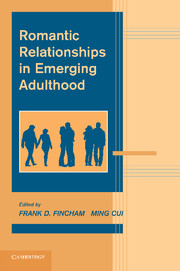Book contents
- Frontmatter
- Contents
- List of Contributors
- Foreword
- PART I INTRODUCTION
- PART II CONCEPTUAL AND METHODOLOGICAL FOUNDATIONS
- PART III THE DEVELOPMENTAL CONTEXT OF ROMANTIC RELATIONSHIPS IN EMERGING ADULTHOOD
- 6 Intergenerational Continuities in Economic Pressure and Couple Conflict in Romantic Relationships
- 7 Linking Parental Divorce and Marital Discord to the Timing of Emerging Adults' Marriage and Cohabitation
- 8 Family Differentiation in Emerging Adulthood: The Role of Romantic Relationships
- PART IV RELATIONSHIP PROCESSES IN EMERGING ADULTHOOD
- PART V PRACTICAL IMPLICATIONS
- Index
- References
7 - Linking Parental Divorce and Marital Discord to the Timing of Emerging Adults' Marriage and Cohabitation
Published online by Cambridge University Press: 06 December 2010
- Frontmatter
- Contents
- List of Contributors
- Foreword
- PART I INTRODUCTION
- PART II CONCEPTUAL AND METHODOLOGICAL FOUNDATIONS
- PART III THE DEVELOPMENTAL CONTEXT OF ROMANTIC RELATIONSHIPS IN EMERGING ADULTHOOD
- 6 Intergenerational Continuities in Economic Pressure and Couple Conflict in Romantic Relationships
- 7 Linking Parental Divorce and Marital Discord to the Timing of Emerging Adults' Marriage and Cohabitation
- 8 Family Differentiation in Emerging Adulthood: The Role of Romantic Relationships
- PART IV RELATIONSHIP PROCESSES IN EMERGING ADULTHOOD
- PART V PRACTICAL IMPLICATIONS
- Index
- References
Summary
Despite the well-documented decline in the marriage rate in the United States over the past several decades, recent research suggests that the majority of people (about 90%) will marry at some point in their lifetimes (e.g., Field, 2003). However, age at first marriage and the prevalence of cohabitation have also increased during this time (Bumpass & Lu, 2000). These changes are closely associated with the social, economic, and other demographic changes that have occurred during this time period.
Research has demonstrated that the timing of initial entry into marriage and cohabitation may influence both the quality and stability of young adults' marital experiences over time (Amato & Booth, 2001; Bumpass, Martin, & Sweet, 1991; South, 1995), as well as other aspects of their lives, such as their psychological well-being (Amato, 2000; Waite, 1995). These findings suggest that the timing of cohabitation and marriage is critical for young adults for the development of intimacy and healthy emotional functioning. Most young adults enter into cohabitation and marriage in their late teens and twenties, a developmental stage known as “emerging adulthood” (i.e., ages 18–29; Arnett, 2000).
Importantly, research has also demonstrated that the timing of entry into cohabitation or marriage may be strongly influenced by experiences in the family of origin, including a history of parental divorce (Wolfinger, 2003, 2005).
- Type
- Chapter
- Information
- Romantic Relationships in Emerging Adulthood , pp. 123 - 141Publisher: Cambridge University PressPrint publication year: 2010
References
- 1
- Cited by



